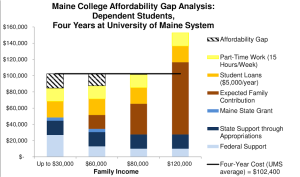College Affordability Gap
Source: Report of the Commission to Study College Affordability and Completion Commission,
To facilitate their understanding of college affordability and to quantify the current ability of Maine’s college students and their families to pay for a college education in Maine, the Commission made use of an Affordability Model developed for the Washington Student Achievement Council by HCM Strategists in a report dated August 21, 2014. The model was designed to answer the questions:
- Is there a viable pathway to a bachelor’s degree—including significant part-time work and student loans—for all state residents?;
- How can state grant policies (amount, eligibility, etc.) increase affordability for students?; and
- Should any policies be modified to support student success?
In brief, the Commission adapted this Affordability Model to determine the total unmet financial need of attending a public institution of higher education for students and their families based on the following factors:
- State support through appropriations;
- Student loans ($5,000 per year);
- Federal support (Pell grants and loan programs);
- Maine State Grant Program ($1,000 annual grant);
- Expected Family contribution; and
- Part-time work (15 hours per week at minimum wage)
With the help of Commission member Lisa Plimpton, Director of Research for the Mitchell Institute, the Commission was able to determine, as portrayed in the above graph, the current unmet financial need (Affordability Gap) of students attending 4 year degree program within the UMS:
In brief, through this analysis, the Commission determined the following:
- For a family with an annual income of up to $30,000, there is a current Affordability Gap of slightly more than $17,000 over a 4 year period after all other available financial sources have been used;
- For a family with an annual income of up to $60,000, there is a current Affordability Gap of almost $15,000 over a 4 year period after all other available financial sources have been used;
- For families with incomes over $60,000, there is not currently an Affordability Gap for the costs of attaining a 4 year degree in the UMS.
The Commission used this information to quantify that there is a significant degree of unmet financial need for the 4 year cost of attending a university within the UMS for families with annual incomes of less than $60,000.

